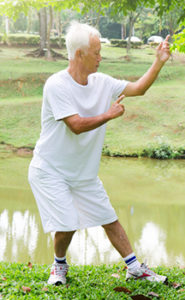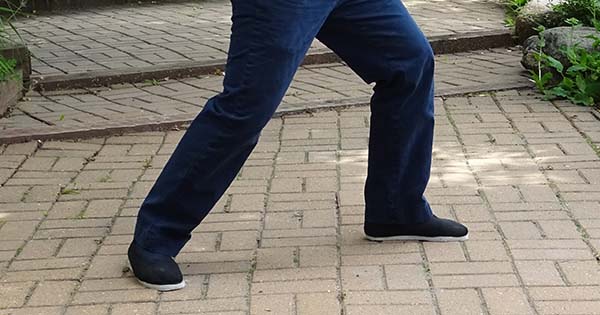Wu also stated (Brennan translation with comment in brackets) “Within each circle, there will be a center, and within each square, there will also be a center, but outwardly this centering will be perceived as ‘balance’ [a state between the nimbleness of roundness and the stability of squareness].”
The centers of both the circle and the square should be maintained in Taijiquan, and the center is what allows both mobility and stability. This way we can use stability and mobility to complement each other and achieve a balance between the circle’s mobility and the square’s stability.
 For example, if one juts out a hip when shifting weight, then the center of that hip is not being maintained. This leads to tension around the joint in order to maintain balance when under pressure, and this tension loses fangsong and reduces the joint’s mobility.
For example, if one juts out a hip when shifting weight, then the center of that hip is not being maintained. This leads to tension around the joint in order to maintain balance when under pressure, and this tension loses fangsong and reduces the joint’s mobility.
By not maintaining the center, one can become “stuck” (lose mobility) when trying to maintain balance (stability). This locked structure also affects stepping since without the hip of the weighted leg being centered over the foot it would be difficult to raise the un-weighted foot.
Maintaining force through the center of a joint both allows greater freedom of movement (the roundness of mobility) and allows force to be transmitted through it (the squareness of stability). When applied to the whole body (the sum of our joints; with the center of mass located in the lower dantien 丹田, cinnabar/elixir field, an area inside the abdomen a few inches below the navel), this maintenance of our center(s) should provide both mobility and stability.
Of course, individual joints have differing requirements. For example, ball joints have greater mobility than hinge joints. Therefore, for example, we practice to have knee stability (knees maintained in the direction of the big toe) while rotating primarily with the hips (song kua 松胯 loosen hips).
Some people who are very flexible may have injuries if they lack strength and stability. Others who are strong and stable can have muscle and joint stiffness due to a lack of flexibility which can also lead to injuries. These extremes are not common in fit martial artists, but they illustrate the problems when there is a lack of balance between stability and mobility.
Another way to look at this is to say that we want both our mobilizing and stabilizing muscles to function optimally. The stabilizers are typically the smaller and deeper muscles that maintain our structure and are sometimes trained using zhan zhuang (站樁 standing like a post). The mobilizing muscles are those that flex and extend our joints, and these are generally the larger and more visible muscles and are used primarily for movement.
Keeping the centers of the joints aligned using our stabilizer muscles allows a better transmission of forces through our structure and into the ground. The more vertically down into our feet we can align incoming or outgoing forces, the better our “root” will be. The better the forces are transmitted through the centers of our joints, the better is our ability to rotate around those joints while maintaining balance and stability.
In the extreme – one leg stances, or when a leg is lifted during a step – the center of our mass should be directly over our planted foot, which provides our base of support. Mobility, the ability to rotate while in one leg stances or mid-stepping, is facilitated when force is transmitted through the centers of our joints.
A long stance may help one since it provides an ability to shift farther backward, without needing to step, in order to lure or pull a partner/opponent, or to advance farther forward, without needing to step, when issuing force against them. But, if the long stance is used to brace against them, then it is likely that horizontal resistance is being used rather than directing force more vertically.
It is not uncommon for practitioners to adapt a parallel stance, with the feet about their body’s width apart, during push-hands (tui shou 推手) training in order to reduce bracing against their training partner. This aids in practicing transmitting force vertically into the root rather than horizontally. We want our mass to drop into our feet (verticality) rather than relying on friction (horizontally) between our feet and the ground.
Another way to practice the difference between vertically and horizontally directed force would be to practice in slippery shoes or on a slippery surface like ice. The more vertically one can transmit forces into their feet, the less slipping there will be when pushing or pulling, or when being pushed or pulled. Once there is less slipping, one should find that a smaller stance can be adopted without greatly affecting ones stability.
Lowering the center of gravity can also help with rooting. A long or wide stance, although it can compromise mobility, can lower ones center of gravity. Lowering the center of gravity allows for a greater angular displacement within the borders of the base of support. This means that one can move farther before losing ones balance.
 Practitioners can also lower their center of gravity by bending their knees more. This is accomplished in some Taijiquan traditions by sinking as if lowering oneself into a chair to counter the legs bracing upward against gravity. It is often advantageous to have ones center of gravity be lower than ones partner/opponent, although we want to do this in a dynamic and mobile way that balances yin with yang.
Practitioners can also lower their center of gravity by bending their knees more. This is accomplished in some Taijiquan traditions by sinking as if lowering oneself into a chair to counter the legs bracing upward against gravity. It is often advantageous to have ones center of gravity be lower than ones partner/opponent, although we want to do this in a dynamic and mobile way that balances yin with yang.
One can check their ability to root by practicing in a pool, where buoyancy counters some of gravity’s downward force. Here one will need to incorporate actively pulling down into the legs as well as keeping the feet solidly on the bottom of the pool, if one wants to maintain a good root.
Finally, leaning (of the torso, or even of just the head) moves our center of gravity away from our center of mass, leading to a decreased angular displacement before losing ones balance due to movement beyond the base of support. Verticality helps maintain stability.
In Taijiquan we want stability and mobility to complement and strengthen each other.

Leave a Reply